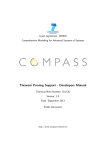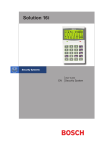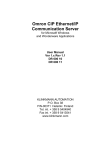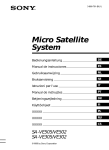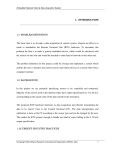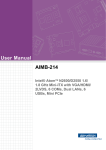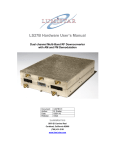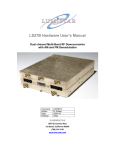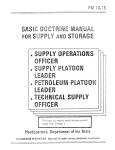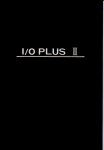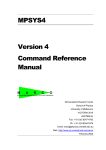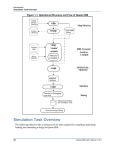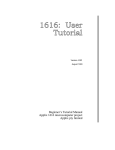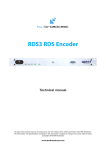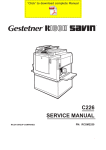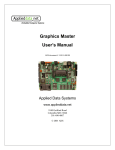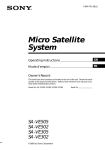Download 1616: User Disk
Transcript
1616: User Disk Version 4.088 August 1993 Beginner’s Disk Reference and Tutorial Manual Applix 1616 microcomputer project Applix pty limited 1616 User Disk Reference and Tutorial Manual Even though Applix has tested the software and reviewed the documentation, Applix makes no warranty or representation, either express or implied, with respect to software, its quality, performance, merchantability, or fitness for a particular purpose. As a result this software is sold "as is," and you the purchaser are assuming the entire risk as to its quality and performance. In no event will Applix be liable for direct, indirect, special, incidental, or consequential damages resulting from any defect in the software or its documentation. The original version of this manual was written by Andrew Morton Additional introductory and tutorial material by Eric Lindsay Editorial and design consultant: Jean Hollis Weber Comments about this manual or the software it describes should be sent to: Applix Pty Limited Lot 1, Kent Street, Yerrinbool, 2575 N.S.W. Australia (048) 839 372 Private Applix BBS numbers include Colin McCormack (02) 543 8213, SSM (02) 554 3114, Trantor (02) 718 6996 and PPT 544 1060. These are all "callback systems" (phone once for two rings, phone them again within 30 seconds). User Group meetings are generally held on the second Saturday of each month, from about 1 p.m. until midnight or so. All computer enthusiasts are welcome, as are new visitors. Come in and meet the designer of the Applix system. Copyright 1986 Applix Pty Limited. All Rights Reserved. Revised material Copyright 1992 Eric Lindsay ISBN 0 947341 xx x MC68000 is a trademark of Motorola Inc. 1 Preparing New Disks A number of utility programs to prepare disks for use are supplied on the 1616/OS V4 User disk. This chapter details how to prepare a new disk for use, how to copy existing disks, how to check your disks for faults, and also how to automatically repair disk faults. Once you get used to the three programs described here, you should be able to use them from day to day without further reference to this chapter. This chapter does not include any technical details of disk operation; technical details are included in the Disk Co-processor Manual, which also contains instructions for building your disk controller card. The various programs described in this chapter are assumed to be in a directory named bin on the disk in drive /f0. Check that they are in their correct place by doing a dir /f0/bin. If they are not there, use the copy command (described in your original User Manual) to copy them into /f0/bin. We also assume that your xpath includes /f0/bin. Check that this is true by typing xpath. If the line displayed does not include /f0/bin, correct your xpath by typing xpath + /f0/bin so that bin is added to your xpath. Please note that if your disk is not set up as described above, some of these programs will not work as described. If a program fails to work as described, the first things to check are the location on disk of the program, and that your xpath is correct. The more you use your Applix 1616, the more you will appreciate the importance of correct program location on disk, and correct xpaths. Initialising block devices Before a brand new, never before used disk can be used, it must be formatted and initialised to suit the type of computer in which it will be used. This process need only be done once in the life of a disk. It involves putting magnetic tracks on the disk, and setting some tracks up in a particular form. Note that this totally destroys anything previously on the disk. You must make very sure that a disk does not contain anything of value before you initialise it. The program blockdev.xrel permits the initialisation of block devices, formatting of floppies and the conversion of 1616/OS V2.X disks to 1616/OS V4.n. This is how you make yourself a totally new disk, ready for use in your 1616. To run this program type blockdev devname Where devname is the name of the device (/f0, /f1, etc) which you wish to format, initialise, etc. For example, if you have a single disk drive, put your User Disk in /f0 and type blockdev /f0. The program will prompt you to remove your User Disk and replace it with the disk you wish to initialise. Preparing New Disks User Reference Page 1 There are three levels of disk preparation available with this blockdev program. The most basic level is to simply alter the disk’s boot sector program; you enter the name of the new boot program and this is written onto the disk. If no boot program exists on a new disk, then the new disk is skipped in the booting sequence. If you wish to boot (start the computer) from a particular disk, it must contain a boot program. The exact details of what is in the boot program is rather involved, and is explained in the Technical Reference Manual, however a step by step tutorial, with some explanation, is provided below. In the next level of disk preparation you may ‘initialise’ a disk. This recreates the disk’s root block, bitmap and directory. All files are lost. The boot sector program in the boot block needs to be rewritten after this. The most intensive level of disk preparation involves a physical format of the disk, followed by initialisation, followed by the boot sector program. This is what is required for a totally new disk. This will only work on the /f0 and /f1 devices, since these are the only physical devices which this program knows how to format. Another option with this program is to upgrade a Version 2 disk to 1616/OS V4. This alters an old Version 2 disk’s root block into the correct format. The V2.X directory becomes the V4.0 root directory. The disk is still readable and writeable under 1616/OS V2.X. This option may be used for altering a disk’s volume name, as well as upgrading the version. How do you format a floppy? Like most operating systems, 1616/OS does not contain routines to do everything you might need. For lengthy, or infrequently used activities, like formatting, special programs are supplied on disk. You will need your 1616/OS User Disk (supplied when you bought 1616/OS version 3 or 4), which has a /bin directory which contains the format program blockdev (version 2 of 1616/OS used sddutil, which is now obsolete). We will assume that you only have a single disk drive; if you have two, you can put the blank disk to be formatted in drive /f1 instead of swapping disks. Before you start, write protect your User disk against mistakes, by flicking open the write protect clip in the corner so you can see through the hole. First, let me mention that there are two types of disks that can be produced. The normal one, which stores programs and data, and a boot disk. The normal disk, as produced by a simple format, is not really suitable for booting your Applix (although the Applix will start up regardless of what sort of disk you use). The boot disk starts up your Applix in a particular way, and can customise what happens when it boots. It can do this because it contains a boot program. The normal boot program, bootv3.exec (sometimes named bootv3) supplied in your User Disk /sys subdirectory, only does a few very simple things. It sets the step rates for /f0 and /f1, and then checks the reset level. If you pressed the reset button, it doesn’t do anything else, except return control. If it is a Level 0 (power on) Page 2 User Reference Preparing New Disks reset, it changes the default drive to whatever drive you booted from. When you are more experienced, you can write your own ‘custom’ boot program, to do more elaborate things. The Applix 1616 will also search for and use a set of memory resident driver programs, which are combined in a file normally named mrdrivers. This installs several modifications to 1616/OS. For example, on the User Disk, the usual mrdrivers file will install a time of day clock (tdos.mrd), which displays the time in the top right hand corner of the display. Next, a start up program is run. The name of this program is provided by the boot program, and it is usually named autoexec.shell. If you read the source code bootv3.s on your User Disk, you will see where the name ‘autoexec’ appears. If you write a custom boot program, this name can be changed. The autoexec.shell program can contain almost any set of commands that you like. Now that we have sketched the background, let us go through formatting an ordinary, non-boot, disk. Place the User Disk in drive /f0, and change to the /bin subdirectory by typing cd bin (if your xpath includes /f0/bin then you need not change to that directory). Start the program by typing blockdev /f0. If you have two disk drives you can specify /f1 instead. The blockdev program will put a menu on your screen. Select the first option, 0. The program will prompt you to put a blank disk in the drive, and press the Spacebar to start the format. To produce an ordinary disk, just press is all there is to it. Enter as the answer to all questions. That The only real complication is that you can not boot your Applix using this disk. Disks that do not have a boot program are skipped when the Applix boots. In my case, this simply means the Applix will end up booting from the hard disk, with the correct autoexec.shell and so on. If you don’t have a hard disk, the Applix will start without running the boot program, without any mrdrivers, and without running an autoexec.shell file. Things will still work, but you should have a boot disk somewhere to start the system with everything set up to suit your way of working. You will find an example of what is contained in the boot program in the bootv3.s source code in the sys subdirectory on your User disk. Since making a boot disk can be somewhat complicated, I’d suggest that the first time, the novice simply copy their User Disk (which is correctly set up as a boot disk) to a newly formatted disk using the diskcopy utility (described below) on the User Disk. Then just delete all the files you no longer need on the new disk. If you wish, you can change the name of your new disk, using the blockdev utility (the original name you put on while formatting was overwritten by the diskcopy.) Preparing New Disks User Reference Page 3 If you really want to do the entire format of a bootable disk, here is a more complete description (assuming one drive). Start with the User Disk in /f0, and start blockdev, by typing blockdev /f0. Select option 0. Press Enter for 80 tracks, and again for 64 root directory entries. Edit the disk name to whatever you like, say /boot. Enter the boot program name as /f0/sys/bootv3.exec (or /f0/sys/bootv3 if that name is used). Put the blank disk in drive /f0 when prompted, and press the spacebar . When the format is finished, quit from blockdev using option 4. Remove the newly formatted disk, and replace the User Disk in the drive. Copy all the files you need to the ram disk /rd. The files you need include mrdrivers, and autoexec.shell from the root directory on the Users Disk. You may also need some extra files from other directories. For example, I need Jeremy Fitzhardinge’s swget.xrel program, which is usually in my /bin directory, and some early Applix boot disks need the ibmfont.xrel file which is also in the /bin subdirectory. After copying these files to /rd, place your newly formatted disk back in the drive, and copy the files from the ram disk to /f0. You will have to also create a /bin directory, for any files that usually reside in a /bin directory (or else change the contents of the xpath command in the autoexec.shell file to coincide with where the programs now exist). You should now have a complete bootable disk, that will start your Applix just like the original. Copying disks The program diskcopy.xrel copies a 1616/OS disk block-for-block to another disk. The copy is identical, except the DATE and SPECIAL fields in the rootblock of the target disk are altered to prevent the system from assuming the two disks are the same (a full description of these fields is in the Disk Coprocessor Manual). Diskcopy is the program you use when you need to make a copy of an entire disk as easily as possible. Usage of this program: diskcopy sourcedev destdev [-f] [-v] [-r] Where sourcedev is the device identifier of the source disk (/f0, /f1, etc) and destdev is the destination disk identifier. If these are the same then you will be prompted to perform disk swaps at the appropriate times (although with one drive, this can be tiresome). Page 4 User Reference Preparing New Disks The -f flag forces physical formatting of the destination disk, saving you the bother of using blockdev. This only works if the destination device is /f0 or /f1 (that is, it won’t work on hard disks or ram disk). The program will prompt you to press the Spacebar prior to doing the formatting. This means that you do not need to use blockdev if only copying disks. The -v flag sets verbose mode: the program prints out more status information as the copy proceeds to reassure you things are working. There is no harm in using it, however later you may wish to find ways to copy disks without further intervention. The -r flag suppresses the re-randomisation of the root block’s DATE and SPECIAL fields, yielding an exact copy of all blocks of the disk. This is not the best of ideas under normal circumstances. An example of the use of this program: diskcopy /f0 /f1 -v -f This will copy from /f0 to /f1, formatting /f1 and printing out status information as the copy proceeds. Checking and repairing file systems The fscheck.xrel utility scans the file system on a disk, reporting any inconsistencies in information on the disk. In short, it both tests and repairs damaged disks, provided the damage is not too severe. This is a very handy program. You should check any disk that was in your system during a crash, just as a precaution. Also, check any disk that appears to be giving problems. For the first test, use the -q option, since it saves time. To use this program, type fscheck devname [-v] [-y] [-yy] [-q] Where devname is /f0, /f1, etc. The -v option, if specified, causes the program to operate in verbose mode, so more status information is printed. If the -y option is provided this program automatically answers ‘yes’ to all its questions, except for the last one where it asks if you wish to write out the disk bitmap; this question must be manually answered. If the -yy option is given all questions, including the last one, are automatically answered in the affirmative. Use this option for a fully automatic repair. If the -q option is given, a simplified and much faster check is made. If a file system passes this without complaining, it should be OK. If it complains, then use the other options for more information. fscheck.xrel does not check the disk for bad disk blocks - these may or may not be detected, depending upon where on the disk they lie. Preparing New Disks User Reference Page 5 Errors detected in operation are repaired by deleting the offending block from the file. The file length is reduced by 1024 bytes (unless the block is at the end of the file). A message is displayed and you are asked whether or not the fix is to be made. The file will probably be corrupted. If a file’s block map block number is an invalid block then the file is deleted. If a directory’s block range is invalid then it is removed. The user is told about all of these things and prompted to confirm. A number of these fixes will cause bitmap inconsistencies, but these are fixed later or on another pass of the file system check program. This program should be rerun until it gives the disk a clean bill of health; it may take several passes to fully repair a disk. If a change is made to the bitmap of a non-removable or hard disk this program exits with a warmboot system call, which is like pressing reset. This must be done because the system never re-reads the bitmap and root block of a non-removable device, so alterations to the bitmap would not be noted if this program exited in the normal manner. Disk names When you format a diskette using the blockdev utility on the user disk, you have the option of giving your diskette a meaningful name. The name can be seen when doing a directory, or by using the volumes command. This can be handy for keeping track of the contents of disks more easily. Page 6 User Reference Preparing New Disks 2 Startup Files The Applix 1616 will start operating without a disk in the drive, unlike many computer systems. Despite this ability, the best way to start the Applix 1616 is with a specially configured disk called a ‘boot disk’, described in the next section of this chapter. The boot disk tells the 1616/OS which file to take startup commands from. This file is typically named something like autoexec.shell. The operation of autoexec.shell files is described in the second section of this chapter. Various rather fundamental changes can be made to the operation of the 1616/OS by means of an mrdrivers file. This allows you to add new commands to the operating system, change existing commands, set default colours, change the ram disk size, and make other changes. Creating mrdrivers files is described in the mrdrivers section of this chapter. Boot disk A boot disk is one that has been produced using the blockdev program described in the previous Chapter. It also includes a special startup program, usually called bootv3, which is placed on the disk when it is first formatted by blockdev. This bootv3 startup program goes in the disk bootblock, and thus is not visible in a directory. Advanced users can specially customise their bootblock program by writing their own boot program, instead of using the sample program bootv3.s provided in the /sys directory of the User Disk. The standard boot program does very little. One thing is to simply adjusts the speed of the disk drive step rate to their fastest settings. The drives are deliberately started with slow settings so that even ancient drives work correctly for boot purposes. More important for you, the bootblock tells the 1616/OS which file contains the commands you want to run each time you start the system. These commands are held in a file named autoexec.shell. By altering the bootv3 program, you can change the name of this program. You can also allow use of a different autoexec program for each reset level. This might mean that different things happen when you power up, than when you press the reset button. Autoexec.shell files The autoexec.shell file simply contains a list of commands for 1616/OS to run. All the commands in it run automatically when you power up your computer. A typical simple autoexec.shell file is shown below: Startup Files User Reference Page 7 bin/swget ; set time and date from Smartwatch mkdir /rd/bin ; make sure some programs can run quick xpath bin /rd/bin ; make all bin dirs accessible copy bin/shutdown.xrel /rd/bin ; copy needed programs copy bin/startup.xrel /rd/bin assign /hitech /f0/hitech ; for C compiler assign /temp /rd assign /usr/lib /f0/usr/lib ; set up for Dr Doc use cd /rd ; go someplace quick As usual with shell files, the ; simply indicates a comment follows. Usually comments are not as detailed as in these examples. First, notice that the 1616/OS assumes that you are getting all your files from root directory of the boot disk. This is a consequence of the actions of the bootv3 program held in the boot block of the boot disk. The first command I use (swget) gets the date and time from a SmartWatch real time clock chip on my Applix 1616 motherboard, and tells the operating system. I always think the $50 cost of that chip and software was worthwhile, because I’m forever forgetting to use setdate when I start a system. Since the ram disk is much faster than an floppy disk, it makes sense to set up a directory on it, and copy over some frequently used files. In my case, they are actually ones used for starting and stopping the hard disk motor (I obviously can’t leave the startup program on the hard disk!) Floppy only users will have other commands they use frequently, perhaps diskcopy, the ssasm assembler, or similar. Notice that one standard place to hold executable (.xrel) files is in a bin subdirectory. Note that the commands in the autoexec.shell file are simply a list of commands. They do not actually do any testing for particular conditions. We will consider ways round this lack in a later chapter. Construct MRDRIVERS file for boot disk A memory resident driver (MRD) is a program that remains in memory at all times, and modifies the actions of the system. The buildmrd program permits the linking together of a number of memory resident driver programs, whilst specifying certain system information that users often like to customise. The result of using this program is a file named mrdrivers. The mrdrivers file is executed when the system boots, provided it is present in the root directory of the boot disk. The various MRD programs placed in memory by this means extend the operation of your 1616, by adding new commands to it, or by changing the operation of old commands. The other major, and perhaps even more important reason for having an mrdrivers file, does not involve MRDs. You can configure your system, specifying the ram disk size, the amount of memory for video, the default colours, the number of command lines for the line editor to capture, and so on. This becomes very Page 8 User Reference Startup Files important if you have little memory, and need to make the most of it. It is even more important if you have lots of memory, for it vastly extends how you can use that memory. The actual options available when using buildmrd are set out below: buildmrd [-rramdisksize] [-ooutfile] [-sstacksize] [-vvideosize] [-ccolours] [-bncacheblock] [-ddircachegiven] [-fmaxfilesgiven] [-lllgiven] [file.mrd] [file.mrd] ... Description of options STACKSIZE is the amount of space reserved for the system stack in kbytes. If this is not specified it defaults to 32 kbytes. If you are heavily into stacking things, or if you run into programs with insufficient stack space, make it 64k or 96k. VIDEOSIZE is the amount of RAM at the top of memory (ending at $80000 on an unexpanded Applix 1616) reserved for video display in kbytes. If not specified this defaults to 32 kbytes (it cannot be made less), usually starting at $78000. If you specify 64 kbytes, for example, it will usually start at $70000. If you will be running EGA video, or mgr, for instance, you need 64 kbytes. You can specify up to a half megabyte of video memory, if you have an expanded Applix 1616. RDSIZE is the size of the RAM disk in kbytes, and should be a multiple of 8 kbytes. If not specified this defaults to 200 kbytes. It cannot be made less than 8k. If the mrdrivers file cannot be found at boot time, the RAM disk size is set according to the setting of bits 0 and 1 of the hardware diagnostic switches. If you have a memory expansion board, give yourself plenty of ram disk room, up to about a megabyte say. COLOURS Colour settings were added to the header structure of the MRDRIVERS file, as at January 1989, with a default setting of 0x1FA50. Bit allocation in this longword is as follows: 00-03 Pallette entry 0 04-07 Pallette entry 1 08-11 Pallette entry 2 12-15 Pallette entry 3 16-19 Border colour This longword is set using the -c flag in buildmrd.xrel, when creating the MRDRIVERS file. For example, -c1fa50 will give a border colour of 1, and pallette entries of 15, 10, 5 and zero (which are actually the default in any case). If the MRDRIVERS file contains zero for the colour setting, the system assumes it is an old version MRDRIVERS file, and sets the colours to the default. Startup Files User Reference Page 9 OUTFILE is the output file pathname. It defaults to mrdrivers. Why bother to change it, unless you are generating some additional, altered, mrdrivers files? This can be of use if you have multiple, different, mrdrivers files, each intended to do slightly different things with memory. NCACHEBLOCK Number of 1 kbyte blocks to devote to cache memory. Don’t worry about using this. DIRCACHEGIVEN Number of directory entries to cache in memory. Default is 20. MAXFILESGIVEN Maximum number of file control blocks open. Just accept the defaults for most things. LLGIVEN Number of lines of input to be retained for use by the ‘recall’ feature of the command line editor. Default is 10, but if you have plenty of memory, increase it wildly! This lets you edit more of the past command lines you used. MRDFILES is a list of zero or more memory resident driver files. By convention these filenames end in ‘.mrd’. If no name extension is given, a .mrd is automatically added. Programs written for MRD use must comply with the guidelines set out in the Technical Reference Manual for memory resident drivers, so you may wish to seek help in writing or converting your first MRD program. Typical MRDs include time display, screen blanking, and various beep programs. Unfortunately, I haven’t organised my disk to use many MRDs, so I can’t really comment about using them extensively. Doing a quick check of my system using find . *.mrd to search turned up code for the following MRDs. assign.mrd Same as assign now present in 1616/OS (early version). beep.mrd crtc.mrd Demonstration that makes a beep sound. Allows you to fiddle with 6545 values on the fly. crtsav.mrd Screen saver, turns off video after a preset period, until a key is touched, by Jeremy Fitzhardinge. except.mrd Exception handler for bug tracing, by Michael Johnson in SW #5. locate.mrd Find data in memory, for program debugging, by Michael Johnson in SW #5 Same as | now present in 1616/OS, an early version. pipe.mrd Page 10 User Reference Startup Files quick.mrd sseg.mrd Shuts down most of video display (and ram refresh) thus speeding up CPU processing by up to 10%. Support for EGA video, from Conal Walsh. tdos.mrd Time of day clock in corner of display. Many of those above were written by Andrew Morton, and are readily available from Applix, either on User Disks, or on Shareware Disks. There are many other MRD programs available. Also, an MRD program is essentially an ordinary program with certain additional facilities added, so many ordinary programs can be turned into an MRD if required. The program mrdstat (from Andrew’s Utility Disk), or Michael Johnson’s readmrd (on Shareware #5) will report on which MRDs you have present in your system. So, why use an MRD? After all, the 1616/OS is fully multitasking, and you can run tasks in background. In truth, from the user’s viewpoint, there isn’t a great deal of difference, except for convenience. You generally want a certain combination of facilities; this combination will depend upon what you are doing. So, for programming work, you want MRDs for bug tracing, while for general work with your computer, you may want, say, a time of day clock. The ideal solution is a number of mrdrivers files, one for each different type of boot disk. One day I’ll add a list of all known MRD programs in this space, but not this time. Boot code I’ve mentioned that Applix 1616 boot disks include a set of code for starting the system in a particular way. The standard, relatively simple, boot code is in /f0/sys and is named bootv3.exec or bootv3. You will also find the assembler source code in the same directory. Various users have made changes to the boot code, to allow more freedom to customise the boot procedure. Startup Files User Reference Page 11 3 Disk Utilities In this section of the manual, we describe some of the utilities available on the Applix User Disk. The utilities are described in alphabetical order, rather than the order in which they are used. Disk Utilities User Reference Page 13 arep - keyboard autorepeat rate arep repetition_ticks initial_delay_ticks Description Allows you to alter the rate at which the keyboard auto-repeats any key that is held down. Each tick is a 50th of a second, and you can set the time between repeats of each letter, and also how long before a held down key starts to autorepeat. The arep daemon does occupy some memory, so if you lack memory space, you may prefer not to use it. Can be a real boon for playing some fast action games. Now, if someone will just do the same thing for the joystick ... Examples arep repetition_ticks initial_delay_ticks Bugs Associated files arep.c See also kv, scan Distribution Early V4 Users Disk /demos Author Andrew Morton Page 14 User Reference Disk Utilities bigbuf - set buffer size for character devices bigbuf [bufsize] [satx] [sarx] [sbtx] [sbrx] [cent] [kb] Description A program that lets you more easily set the size of the character buffer for any of the I/O devices. The default buffer size is set to $4000 (16k bytes), while the minimum allowed is 32 characters. Of most use when running a serial port in background, or for making up a defacto printer buffer. Examples bigbuf 1024 kb sets keyboard buffer to 1k. bigbuf 4096 cent sets printer buffer to 4k. Bugs Associated files bigbuf.c See also Distribution Users Disk V4.0b /source Author Andrew Morton Disk Utilities User Reference Page 15 blockdev - initialising block devices blockdev devname Description The program blockdev.xrel permits the initialisation of block devices, formatting of floppies and the conversion of 1616/OS V2.X disks to 1616/OS V3.n and later. Where devname is the name of the device (/f0, /f1, etc) which you wish to format, initialise, etc. There are three levels of disk preparation available with this program. The most basic level is to simply alter the disk’s boot sector program; you enter the name of the new boot program (usually sys/bootv3) and this is written onto the disk. In the next level of disk preparation you may ‘initialise’ a disk. This recreates the disk’s root block, bitmap and directory. All files are lost. The boot block needs to be rewritten after this. The next level of disk preparation involves a physical format of the disk, followed by initialisation, followed by the boot code setup. Associated files blockdev.c bootv3.s Distribution Users disk Author Andrew Morton Page 16 User Reference Disk Utilities bootv3 - boot program for disk You don’t actually run this - it runs you! Description This program occupies a bootable disk’s boot sector, and determines what actually happens when the 1616 is booted. Normally it simply sets the floppy disk step rates, and then tries to run the autoexec.shell program. You can alter this to anything you like, by rewriting the original source code (provided). Make sure it isn’t too large for a single sector on disk. It isn’t intended for beginners to change; it is just something you use. Examples Bugs Associated files bootv3.s See also Distribution User Disk V4.0b /sys Author Andrew Morton Disk Utilities User Reference Page 17 bug - early mousecall demonstration bug & Description bug & generates a shape that wanders over the display, in background mode, until cancelled using kill. It can only run asynchronously. You can slow down your display something wonderful if you invoke it a dozen or so times (also makes things fairly unreadable, even though it does restore text after itself). Look at the C code to see how to alter the shape. Notice that the early Version 4 manuals had errors in the description of the mousetrap call. Tells you to buy new roms if you don’t have Version 4. Examples Bugs If the screen scrolls while bugs are present, left over bits get stuck to the display. Only if you consider the display as emulating a windscreen, can this be considered a feature! Associated files bug.c See also Distribution User Disk V4.0b /demo/bug/ Author Andrew Morton Page 18 User Reference Disk Utilities buildmrd - construct MRDRIVERS file for boot disk buildmrd [-rramdisksize] [-ooutfile] [-sstacksize] [-vvideosize] [-ccolours] [-bncacheblock] [-ddircachegiven] [-fmaxfilesgiven] [-lllgiven] [file.mrd] [file.mrd] ... Description This program permits the linking together of a number of memory resident driver programs, whilst specifying certain system information that users often like to customise. A memory resident driver (MRD) is a program that remains in memory at all times, and modifies the actions of the system. Typical MRDs include the time display, screen blanking, various beep programs. STACKSIZE is the amount of space reserved for the system stack in kbytes. If this is not specified it defaults to 32 kbytes. If you are heavily into FORTH, make it 64k or 96k. VIDEOSIZE is the amount of RAM at the top of memory (usually ending at $80000) reserved for video display in kbytes. If not specified this defaults to 32 kbytes (it cannot be made less), usually starting at $78000. If you specify 64 kbytes, for example, it will usually start at $70000. RDSIZE is the size of the RAM disk in kbytes, and should be a multiple of 8 kbytes. If not specified this defaults to 200 kbytes. It cannot be made less than 8k. If the mrdrivers file cannot be found at boot time, the RAM disk size is set according to the setting of bits 0 and 1 of the hardware diagnostic switches. COLOURS Colour settings have been added to the header structure of the MRDRIVERS file, as at January 1989, with a default setting of 0x1FA50. Bit allocation in this longword is as follows: 00-03 Pallette entry 0 04-07 Pallette entry 1 08-11 Pallette entry 2 12-15 Pallette entry 3 16-19 Border colour This longword is set using the -c flag in buildmrd.xrel, when creating the MRDRIVERS file. For example, -c1fa50 will give a border colour of 1, and pallette entries of 15, 10, 5 and zero (which Disk Utilities User Reference Page 19 are actually the default in any case). If the MRDRIVERS file contains zero for the colour setting, the system assumes it is an old version MRDRIVERS file, and sets the colours to the default. OUTFILE is the output file pathname. It defaults to mrdrivers. NCACHEBLOCK Number of 1 kbyte blocks to devote to cache memory. DIRCACHEGIVEN Number of directory entries to cache in memory. Default is 20. MAXFILESGIVEN Maximum number of file control blocks open. LLGIVEN Number of lines of input to be retained for use by the ‘recall’ feature of the command line editor. Default is 10, but if you have plenty of memory, increase it wildly! MRDFILES is a list of zero or more memory resident driver files. By convention these filenames end in ‘.mrd’. If no name extension is given, a .mrd is automatically added. These programs must comply with the guideslines set out in the Technical Reference Manual for memory resident drivers. One day I’ll add a list of all known MRD programs in this space, but not this time. Examples Bugs Associated files buildmrd.c See also mrdstat Distribution Users Disk V4.2 Author Andrew Morton Page 20 User Reference Disk Utilities chdev - change character devices chdev [device:] [-q] [setting ... ] [setting=VAL ... ] Description Program allows lots of changes to the default settings of character oriented devices, which include CON:, SA:, SB: CENT:, NULL: and TTY:. If you are running 1616/OS earlier than Version 4.2, tells you to buy new roms. If running a later version, warns of possible incompatibilities. This is a (somewhat) easier way of using the extensive range of commands made available in the cdmisc system call described in the Technical Reference Manual. The -q or -b option gives a list of possible setting, while the dev: device allows changes to standard input (whatever that happens to be). You can alter or examine the following settings, most of which are for the serial ports SA: or SB: * baud , baud rate (speed) setting of serial ports. Standard values are 300, 600, 1200, 2400, 4800, 9600, 19200, 38400. There may be problems updating with values higher than this, or with non-standard values higher than 2400. * rxbits , number of bits to receive, 5, 6, 7, or 8 (7 or 8 are usual, depending upon the parity setting). * txbits , number of bits to transmit, 5, 6, 7, or 8 (7 or 8 are usual). * parity , a check bit, 0 for no parity, 1 for odd parity, 2 for even parity. If rxbits or txbits are 7 bits, then even parity is usual. If using 8 bits, then no parity is usual. stopbits *, the number of transmitted stop bits sent after each byte. 0 gives 1 stop bit (the usual setting), 1 gives 1.5 stop bits, 2 gives 2 stop bits. ll the number of last lines retained from this device, for the line edit history. sigchar, read or set signal character. The device driver compares incoming characters with the ‘sigintchar’. When a match occurs, a SIGINT signal is sent to the process running the device. The ‘sigintchar’ for the CON: device is normally $83 ( Alt Ctrl C . Set to .256 to disable. eofchar, the end of file character. Use 4 ( Ctrl ) for UNIX, .26 ( Ctrl CP/M or MS-DOS. Default is .256, or no end of file character. D Z ) for * resetchar , set or read the reset character, and perform a warmboot system cal if found. The CON: driver uses $92 .256 to disable. Disk Utilities Alt Ctrl R as the reset character. Use User Reference Page 21 xonchar, the xon character, used by a device for software handshake. The default for the CON: device is $D1 ( Alt Q . The default for a serial device is .17 ( Ctrl Q ), and this tells the serial device to resume transmitting. xoffchar, the xoff character, sometimes used by a serial device for software handshake. The default for the CON: device is $D3 ( Alt S ). Set to .256 to disable. The default for a serial device is .19 ( Ctrl S ), and this tells the serial device to cease transmitting. rawmode, can be set to disable all inout processing. All characters, including SIGINT, resets, xon, xoff are passed along. Can be dangerous, so read the manual first. * sigint , send a SIGINT signal to the process running the device, when it matches an incoming character with the ‘sigintchar’. This is how the Alt Ctrl C works. sighup *, send a SIGHUP signal to the process running a device, when it matches an incoming character with the ‘sigintchar’. killuser, invoke the killuser system call upon the process running the device upon receipt of the ‘sigintchar’. * dtr , send a DTR (data terminal ready) output signal on pin 9 of the serial port. * rts , send a RTS (request to send) output signal on pin 3 of the serial port. dcd, read DCD (data carrier detect) input line on pin 8 of the serial port. cts, read CTS (clear to send) input line on pin 2 of serial port. break *, set or read the break condition on the transmitter of the addressed device. * hfc , hardware flow control on or off. In the default (on) mode for the serial (SCC) ports, the DCD line (pin 8) qualifies receive date, CTS (pin 2) is used for hardware flow control, DTR (pin 9) is always asserted, while RTS (pin 3) is negated when the device receive buffer is nearly full. When hfc is disabled, both RTS and DTR are asserted by the SCC serial port. The port then runs in three wire (pins 1, 4 and 5) mode, completely ignoring all handshake signals. * hupmode hangup (stop serial port) when DCD line (pin 8) goes low (that is, when the caller hangs up the phone). hasmisc, shows if a miscellaneous entry point vector is installed. * perms , set or read permission bits. txcount, number of characters in serial transmit buffer. rxcount, number of characters in serial receive buffer. txroom, bytes free in transmit buffer before it is overrun. Page 22 User Reference Disk Utilities rxroom, bytes free in receive buffer before it is overrun. txflush, flush transmit buffer upon completion of output. txpurge, zero transmit buffer, dumping all pending output. rxpurge, zero receive buffer, dumping all pending input. rxpeek, peek at next character that will be read from the input device by a read, getchar or similar system call. Returns -1 if not character available. version, tells version number of low-level device driver, or 1616/OS version for device within operating system. * txbsize , current transmit buffer size. rxbsize *, current receive buffer size. rxtotal, channel receive count. txtotal, channel transmit count. * xlateesc , enable Televideo 950 escape code translation to some other set of escape codes. rxsigpurge, purge receive buffer upon receipt of signal. txsigpurge, purge transmit buffer upon receipt of signal. A number of these commands can only be used by UID 0 (the user at the console). This is to prevent dial-in users from altering sensitive settings. These settings are marked with a *. Examples Bugs Associated files chdev.c See also Distribution Users Disk V4.2 Author Andrew Morton Disk Utilities User Reference Page 23 chmem - change stack memory usage chmem stackspace files ... Description Lets you specify the amount of stack space (in k bbytes) to be made available to a list of .xrel programs. As memory is a scarce resource, you may find that the default stack size (usually set by your mrdrivers file) is insufficient for certain programs (for instance, the sort program will usually occupy additional stack space). If you get an error message suggesting the use of chmem, that is a pretty good indication of insufficient stack space. Conversely, you may wish to decrease the stack size for programs that make little use of the stack. The stackspace is specified in kilobytes. See the runstats 129, 8 system call in the Programmers Manual or Technical Reference Manual for checking the actual memory usage of a program. Examples Bugs Associated files chmem.c See also Distribution Users Disk V4.0b /source Author Andrew Morton Page 24 User Reference Disk Utilities chmod - change the attribute bits chmod [+rwxabhl] [-rwxabhl] file [files ... ] Description Lets you more easily modify the attribute bits of files or directories, instead of using the inbuilt filemode command. Instead of using a binary mask, you set attribute bits on using the + option, or off using the - option. The meanings are permit read, write, or execute. Set archive, boring, hidden or locked bit. Read, write, execute and hidden bits do not apply to UID 0 (the user at the console), but only to other UIDs. The archive bit can be used to identify files to be backed up. Locked files are ones that can not be deleted. Boring files are ones that do not ned to be backed up, because they are not altered. Examples Bugs Associated files chmod.c See also Distribution Users Disk V4.2 Author Andrew Morton Disk Utilities User Reference Page 25 chown - change the ownership of files chown UID | username file [files ... ] Description Lets you more easily modify the ownership of files or directories, by altering the User Identification (UID). Only UID 0 can alter files to UID 0. Chown looks in a file /etc/passwd for a user name corresponding to a UID, complains and exits if that user name is not available. Examples Bugs Associated files chown.c /etc/passwd The structure of the password file is similar to UNIX. It consists of a number of lines, each with a similar structure. Each line contains various fields, separated by a : character. For example, eric::20:3:eric lindsay:/H0/users/eric:sstools The fields are: Login or user name Encrypted password (can be blank) User ID (a long integer number) Group ID (a long integer number) Description of user User’s home directory Default startup program, a shell if nil See also chmod Distribution Users Disk V4.2 Author Andrew Morton Page 26 User Reference Disk Utilities diskcopy - make exact copy of disks diskcopy sourcedev destdev [-f] [-r] [-s] [-v] Description The program diskcopy.xrel copies a 1616/OS disk block-for-block to another disk. The DATE and SPECIAL fields in the rootblock of the target disk are altered to prevent the system from assuming the two disks are the same. Where sourcedev is the device identifier of the source disk (/f0, /f1, etc) and destdev is the destination disk identifier. If these are the same then you will be prompted to perform disk swaps at the appropriate times. The latest version knows about multiple block copying, and uses it unless the -s flag is used. It knows to check for floppy only, and knows difference between memory sizes returned in V3.3 and V4.1. Checks for and will run as an asynchronous (background) process. forces physical formatting of the destination disk. This only works if the destination device is /f0 or /f1. -r suppresses the re-randomisation of the root block’s DATE and SPECIAL fields, yielding an exact copy of all blocks of the disk. -s forces single block copying -f -v sets verbose mode: the program prints out more status information as the copy proceeds. Examples diskcopy /f0 /f1 -v -f This will copy from /f0 to /f1, formatting /f1 and printing out status information as the copy proceeds. Bugs Can not handle different sized disks. Associated files diskcopy.c Distribution Users Disk V4.0b /source Author Andrew Morton Disk Utilities User Reference Page 27 fileclean - clean up a file fileclean filename Description Converts a file into 1616 text format by stripping the top bit, ignoring control characters, and ensuring correct CR/LF sequences. Examples Bugs Associated files fileclean.c See also Distribution User Disk V4.0b /source Author Andrew Morton Page 28 User Reference Disk Utilities forever - repeat a command forever forever command Description forever command simply keeps repeating a command, until cancelled using kill. Great for demonstrating that the multitasking really does work. Examples Bugs The first forever under vcon is hard to kill off. Associated files forever.c See also Distribution User Disk V4.0b /source Author Andrew Morton Disk Utilities User Reference Page 29 fscheck - checking and repairing file systems fscheck devname [-v] [-y] [-yy] [-q] Description The fscheck.xrel utility scans the file system on a disk, reporting any inconsistencies in information on the disk. devname is /f0, /f1, etc. -v causes the program to operate in verbose mode, so more status information is printed. -y automatically answers ‘yes’ to all its questions, except for the last one where it asks if you wish to write out the disk bitmap; this question must be manually answered. -yy all questions, including the last one, are automatically answered in the affirmative. Automatic file repair, regardless of risk. -q a simplified and much faster check is made. If a file system passes this without complaining, it should be OK. If it complains, then use the other options for more information. Only available from July 1989 on. fscheck.xrel does not check the disk for bad disk blocks - these may or may not be detected, depending upon where on the disk they lie. Errors detected in operation are repaired by deleting the offending block from the file. The file length is reduced by 1024 bytes (unless the block is at the end of the file). A message is displayed and you are asked whether or not the fix is to be made. The file will probably be corrupted. If a file’s block map block number is an invalid block then the file is deleted. If a directory’s block range is invalid then it is removed. The user is told about all of these things and prompted to confirm. A number of these fixes will cause bitmap inconsistencies, but these are fixed later or on another pass of the file system check program. This program should be rerun until it gives the disk a clean bill of health; it may take several passes to fully repair a disk. If a change is made to the bitmap of a non-removable disk this program exits with a warmboot system call, which is like pressing reset. This must be done because the system never re-reads the bitmap and root block of a non-removable device, so alterations to the bitmap would not be noted if this program exited in the normal manner. Examples fscheck -v -yy /f0 Page 30 User Reference Disk Utilities Bugs Takes forever on a large file system, such as a hard disk (take the yy option and go to bed). Probably will die on a really large file system (say 40 megabytes). Associated files fscheck.c Distribution V4.0b User disk /bin Author Andrew Morton Disk Utilities User Reference Page 31 genreloc - produce relocatable format file genreloc fname1 fname2 ofname [bsssize] Description This program reads and crunches two otherwise identical .exec files (fname1 and fname2), the execution addresses of which differ by the magic number 0x20002, to produce a relocatable format output file (ofname), with an .xrel extension. You can optionally specify the bsssize. It is used because the built in ssasm assembler can not directly produce .xrel files (yes, I know about the -r option, and will tell you when it actually works properly). When a program you are developing is complete and tested, use the makexrel.shell program. This simply runs your code through the assembler twice, with an ORG that differs by 0x20002, and invokes genreloc to produce the final .xrel file. Note that genreloc may complain about stack space. Use chmem to fix it. genreloc will locate phase errors (that is, the two programs weren’t identical), and warn if it finds no relocations (possible lack of ORG statement error). It reports the number of bytes of code, and the number of relocations. Examples makexrel filename (use the shell, to avoid typing long commands). Bugs Always has the wrong stack size. Use chmem to fix that. Associated files genreloc.c See also makexrel.shell Distribution User Disk V4.0b /source or Utilities/lisasource Author Andrew Morton Page 32 User Reference Disk Utilities ibmfont - replace screen font with IBM lookalike ibmfont Description Reload the 1616 screen font with an IBM PC compatible font. The source contains the expected vast number of character bit maps, so it is simple, but long. Examples Bugs Associated files ibmfont.s See also Distribution User Disk V3 /sys /bin Author Andrew Morton Disk Utilities User Reference Page 33 if - command line options if command then command [else command] Description Why give up just because a command returns an error. Use this instead! Check out the test program also. Examples Bugs Associated files if.c See also Distribution User Disk V4.2 Author Andrew Morton Page 34 User Reference Disk Utilities killpg - signal a process group killpg [-nn] process_group [process_group ... ] Description Send a signal to a process group. -nn is the signal number to send. If no signal is specified, the kill is sent as a default. The signals available are described in the include file signal.h, and are similar to UNIX. Not all are appropriate. 1 2 3 4 5 6 7 8 9 10 11 12 13 14 15 16 17 18 19 20 21 22 23 sighup signit sigquit sigill sigtrap sigiot sigemt sigfpe sigkill sigbus sigsegv sigsys sigpipe sigalrm sigterm sigusr1 sigusr2 sigcld sigpwr sigstop sigcont sigexit sigblockrx hangup line interrupt ^C or break quit ^\ illegal instruction trace trap IOT instruction EMT instruction floating point exception kill, cannot be caught or ignored bus error segmentation violation bad argument to system call write on pipe with no-one to read alarm clock software termination signal from kill user defined signal 1 user defined signal 2 death of a child power fail restart (not used) suspend process restart process someone exited someone sent us an IPC block Examples Bugs Associated files killpg.c See also Disk Utilities User Reference Page 35 Distribution User Disk V4.2 Author Andrew Morton Page 36 User Reference Disk Utilities loadreloc - convert .xrel file to .exec file loadreloc ifname.xrel Description Reads ifname, an .xrel file, into memory at $8000, and then converts it into an .exec style program. I’m not at all sure why Andrew needed this one. Probably left over from the old days. Examples Bugs Associated files loadreloc.c See also Distribution Utilities/lisasource Author Andrew Morton Disk Utilities User Reference Page 37 mem - memory useage daemon mem logfile Description mem logfile is a memory usage daemon, used for checking how much memory is being used. Examples Bugs Associated files mem.c See also Jeremy Fitzhardinge has done a much more involved version. Distribution Early V4 User /demo Author Andrew Morton Page 38 User Reference Disk Utilities mrdstat - details of MRDs resident mrdstat Description mrdstat dumps out information about the current memory-resident driver installation. Latest version gives details of the magic number, ram disk size, memory usage, stack space allocated, video ram allocated, mrd start address, ram disk start address, bitmaps, default colour palette entries, number of last lines allocated, number of file cache blocks, and directory cache entries. Very handy when you can’t recall what the hell is currently loaded in memory from your most recent boot. Examples Bugs Associated files mrdstat.c See also Distribution User Disk V4.2 Author Andrew Morton Disk Utilities User Reference Page 39 newsetal - test alias system call alias [on] [off] [exit] [list] [max_alias] Description Place logfile in /usr/lib/alias Won’t work without 1616/OS V4.2 or later. Allows up to 100 entries. Must run asynchronously. Includes lockin (reentrant protection) in code. I couldn’t for the life of me work out what Andrew is doing with this one! Couldn’t work out the (undocumented) syscall either. Examples Bugs Associated files newsetal.c /usr/lib/aliases (the log file) See also setalias Distribution User Disk V4.2 Author Andrew Morton Page 40 User Reference Disk Utilities nice - set CPOU use of live process nice nice_level [pid] [pid ... ] Description Set the nice level of a running process. Reduce the number of time slices a process gets, so that it takes up less of the CPUs effort. For instance, setting a lower priority for printer spooling could be a good move, since printers are generally too slow to keep up anyway. The available levels are 0 to 9. Examples Bugs Associated files nice.c See also Distribution User Disk V4.2 Author Andrew Morton Disk Utilities User Reference Page 41 pcrip - shoot the IBM game pcrip Description pcrip is a game where you get to shoot moving IBM computers. Note that XT’s move slowly, AT’s move faster, and PS/2’s move with a jerk (take that however you like) because of the multitasking. Good for testing your joystick (mine is utterly destroyed). If it is too frustrating, try Jeremy Fitzhardinge’s version (probably under the same name), with far more PCs to shoot, and a shotgun, instead of single shots. Examples Bugs Associated files pcrip.c See also Distribution User Disk V4.0b /demos/pcrip Author Andrew Morton Page 42 User Reference Disk Utilities ps2 - process status ps2 Description ps2 indicates the status of all processes currently running under 1616/OS. It will complain if you attempt to run it on a non-multitasking version of 1616/OS. Looks very similar to the inbuilt ps command, but at least you get to read the code and find out how it was done. There are numerous variations, from Andrew and others, floating round giving slightly different information, and the code is easy to change. Examples Bugs Associated files ps2.c See also ps Distribution User Disk V4.0b /source Author Andrew Morton Disk Utilities User Reference Page 43 rawcopy - copy Minix or other disk rawcopy sourcedevice destdevice Description Use low level commands to copy a foreign file system disk, such as a Minix file system. Examples Bugs Associated files No source provided. See also Distribution User Disk V3 /bin Author Andrew Morton Page 44 User Reference Disk Utilities readuid - read out the user ID number readuid Description A short program to read the User ID number of another user. Examples Bugs Associated files readuid.c See also setuid Distribution User Disk V4.2 Author Andrew Morton Disk Utilities User Reference Page 45 relcc - C compiler preprocessor - SW#6 relcc [-acdijlorsuv] file Description relcc is a preprocessor to the Hitech C compiler. It allows you to produce .xrel relocatable programs. You use it instead of the HiTech C compiler, however you MUST have bought a copy of all the rest of the HiTech C before this will do anything. -a -c -d -h -i Don’t link, use the .obj file. Write out l.sym symbol table information in the current directory, for use by the Minix debugger (I think). Location of the include files, typically -i/hitech/include. -l Specify -jmrd_crtapp.obj in command line, if attempting to produce an MRD driver. Libraries to be added -n -o Lets you capture output without compiling. Optimise, if invoked. -j -r Disable relocatable (.xrel) output if invoked. Code produced is in .exec form. -s -u -v Verbose mode if invoked. Disks should be set up with the following assigns. assign /temp /rd OR assign /temp . assign /hitech /h0/hitech OR assign /hitech /f0/hitech as appropriate. Note that libc.lib, libf.lib etc., should be placed in the /hitech directory. Don’t ask me; I couldn’t follow what half the code was doing. Examples Bugs Page 46 User Reference Disk Utilities Associated files relcc.c, kmem.c See also c.c (on Hitech C compiler disk) Distribution User Disk V4.0b /source, SW#6 Author Andrew Morton Disk Utilities User Reference Page 47 renlower - rename files in lower case renlower [file] [file] ... renupper [file] [file] ... Description renlower filename reads the names of files from the command line, or from standard input, and changes them from upper case to lower case. It accepts wildcards, and also changes the names of directories. Can be used with pipes from the output of find to locate all examples of a particular style of filename, in any directory. renupper is a basically identical program, slightly reworked to have the opposite effect. Examples Bugs Associated files renlower.c renupper.c See also Distribution User Disk V4.0b /source Author Andrew Morton Page 48 User Reference Disk Utilities setalias - set an alias setalias [max_alias] Description Possibly an earlier version of newsetal, listed earlier. Allows you to set a maximum of 10 aliases. Examples Bugs Associated files setalias.c See also Distribution User Disk V4.2 Author Andrew Morton Disk Utilities User Reference Page 49 setenv - set an environment for a user setenv [-q] [-v] List long help setenv ENVVAR=SETTING Adds a setting setenv ENVVAR Deletes setting Description The setenv program allows us to manipulate the user’s environment, in a manner similar to that provided by the inbuilt option command. When running multiple users, it has the advantage that many different environments (one per user) can be established. The ENVVAR item is replaced by any of the following terms, whose meanings are given below. prompten Enable working directory in prompt verbose Enable verbose mode dirmode0 Sort directory by date dirmode1 Sort directory by name ibbeep Enable bell on command error nobak Disable .bak file generation by editors errbeep Enable bell on all errors hidefiles Hide files with hidden bit set assignprompt Use assigns to shorten prompt lowernames Enable lower case file names promptgt Enable > in prompt dodsign Do $ exec environ substitutions doarg Do all argument environ substitutions doarg0 Do command name environ substitutions noshellout Deny shell escapes from applications Complains if you don’t have at least Version 4.2 EPROMS. Expects to have a file /usr/lib/environ on the current device as the location of the default environment details. Examples Bugs Associated files setenv.c /usr/lib/environ See also Page 50 User Reference Disk Utilities Distribution User Disk V4.2 Author Andrew Morton Disk Utilities User Reference Page 51 setuid - start a shell for new user setuid -uUID -mUMASK Description Start a shell for a new user, specifying the user number (1 to 64k), and the user file permissions mask. Examples Bugs Associated files setuid.c See also umask Distribution User Disk V4.2 Author Andrew Morton Page 52 User Reference Disk Utilities sset - front end for set command sset [-l] name[=setting] [name=setting ...] Description A front end for the rather complicated set command, used to arrange replacement of string variables by other string settings, and save the new settings in a file $(HOME)/settings.shell. You should arrange to modify your bootv3 boot file so that autoexec1.shell and autoexec2.shell files are executed upon Level 1 and Level 2 resets. Both these autoexec files should then execute the $(HOME)/settings.shell file, so as to restore your previous environment strings. sset -l reloads all settings from the $(HOME)/settings.shell file. You should set HOME=/pathname/home_directory. Some environment strings have special meanings. For example, ‘home’, ‘path’, ‘lowbaud’. If I ever get round to figuring it out, I’ll document it. Examples Bugs Associated files sset.c $(HOME)/settings.shell See also Distribution User Disk V4.2 Author Andrew Morton Disk Utilities User Reference Page 53 start - start a process stop - stop a process start pid [pid ...] stop pid [pid ... ] Description Stop and start processes, without throwing them out of memory, and without the need to reload from disk. Examples Bugs Associated files start.c stop.c See also Distribution User Disk V4.2 Author Andrew Morton Page 54 User Reference Disk Utilities test - give information about files test command filename Description A general purpose test for the nature of files. There are six forms: test test test test test test + + + + + + - isthere filename - isdir filename - isolder filename1 filename2 - islarger filename1 filename2 - hasextent filename.extent - error command Examples Bugs Associated files test.c See also if Distribution User Disk V4.2 Author Andrew Morton Disk Utilities User Reference Page 55 tstint - test whether interactive tstint Description Uses syscall 129,16 to determine whether a program is interactive or not, and whether it can run in background. Examples Bugs Associated files tstint.c See also Distribution User Disk V4 /demos Author Andrew Morton Page 56 User Reference Disk Utilities trace - demonstrate trace mode trace Description Demonstrates assembler trace mode stepping. Examples Bugs Associated files trace.s See also Distribution User Disk V4 /ssasm_srce Author Andrew Morton Disk Utilities User Reference Page 57 tune3 - play music tune3 musicfile Description Plays musical notes, according to a list in a music file. The macro capabilities of the ssasm assembler are used to turn a text file into a format suitable for playing using tune3. The text files are normally given the extension .mus, but must have a .s extension prior to being assembled. The resulting .exec file is renamed to get rid of the .exec extension prior to being played. copy roncalli.mus yourfile.s (This makes a copy in assembler format) edit yourfile.s (Modify to the tune you require) ssasm yourfile (Assemble the file, including macros) rename yourfile.exec yourfile (Get rid of the exec suffix) tune3 yourfile (Play the tune) Now you will need to know just what you should do when editing. The keywords used in editing music files are as follows: TEMPO Specify a number for the slowness of the piece, e.g.3000. DECAY VOLUME Part#, value. part# is 1,2 or 3. Value is 1 (long) to 4 (short). Part#, value. Values can range from 0 (off) to 255 (full). CHORD Duration, Pitch1, Pitch2, Pitch3 Duration is 1 (quave), 2 (crotchet), 4 (minim), 8 (semibreve) etc. Pitch is 1 (C below bass clef), and increasing in semitones to about 50. Modifications (notes by Lindsay Scales) To make the notes easier to write, and more readable, make these simple modifications to provide note names (these are a subset of the MIDI range). Edit compose.mac to add the contents of musicdefs.mac and compose2.mac. Then add the following equates, where: N specifies a musical note (to prevent confusion with address and data register equates). C is the note name (A, B, C, D, E, F, G). F or S is added to indicate sharps or flats. 3, 4, 5, 6 is the octave number, spanning from A flat to G sharp. Page 58 User Reference Disk Utilities eg. NC3 NCS3 NDF3 ND3 ... NGS3 NAF4 ... EQU EQU EQU EQU ... EQU EQU ... 1 2 2 3 ... 9 9 ... Lowest note in Tune3 Provide both a sharp and flat name for note more notes Octave changes after G sharp Another octave, and repeat ... Finally, change the Include statements in the .s (.mus) file to: include compose.mac. Other equates could also be used, such as long equ 1 for note decays, crotchet equ 2 for note values, and ff equ 255 for note loudness. This system of macro expansions would be quite valuable for other applications, where data files need to be knocked up quickly, such as MIDI data, bit mapped graphics file headers, setup files for printers, etc. Quibbles Andrew didn’t document this. Associated files ssasm.xrel, tune3.xrel, musicdefs.mac, compose2.mac Music files by Andrew: roncalli, bach Music files by Craig Mills: duel, green, maid, saints, short, stairway, wedding on SW#9 /mills See also sound, play, etc. Distribution Tune3 on various User Disks. Music files by Craig Mills on SW#9 /mills Author Andrew Morton. Disk Utilities User Reference Page 59 uid - display and change user identification uid uid n uid n files uid n - Description uid displays the current user ID (default is 0). uid n changes the current UID to n. uid n files changes the UID on the specified list of files. uid n - reads a list of filenames from standard input, and changes the UID on each of them. User IDs are a number, from 0 (unrestricted) to 65535. You can restrict file access on dial up lines by using them. Examples Bugs Associated files uid.c See also Distribution User Disk V4.0b /source /bin Author Andrew Morton Page 60 User Reference Disk Utilities umask - set user file permissions mask umask -albhrwx [-] [-v] [file] [file] ... Description umask eases the task of setting file permissions. Accepts a list of filenames on the command line, or reads from standard input. The options include a l Archived or backed up Locked against deleting b h Boring, don’t bother to archive Hidden, if required by environment r w Read permissions given Write permissions given x - eXecute permissions given read file names from standard input v Verbose mode Examples Bugs Associated files umask.c See also Distribution User disk V4.0b /source Author Andrew Morton Disk Utilities User Reference Page 61 vcon - virtual console, video context switcher vcon vconp Description vcon Use the Alt 0 keys, the screen to screen. Alt 1 keys, the Alt 2 keys, etc., to change from quit in all windows to terminate the program. Two versions, one does multiple full screen switches, the other puts three smaller windows on a single display. Tells you to buy new roms if you try to run it without having 1616/OS Version 4. Must run synchronously, not in background. Examples Bugs Associated files vcon.c See also Distribution User Disk V4.0b /demos/vcon Author Andrew Morton Page 62 User Reference Disk Utilities vcon2 - new virtual console, video context switcher vcon2 Description vcon2 Use the Alt 0 keys, the Alt 1 keys, the Alt 2 keys, etc., to change from screen to screen. Use Alt S to stop a process. quit in all windows to terminate the program. Can not be run in asynchronously, in background. New versions, does multiple full page window changes. Tells you to buy new roms if you try to run it without having 1616/OS Version 4. Must run synchronously, not in background. Examples Bugs Associated files vcon.c See also Distribution User Disk V4.0b /demos/vcon Author Andrew Morton Disk Utilities User Reference Page 63 4 Summary Appendix A arep repetition_ticks initial_delay_ticks bigbuf [bufsize] [satx] [sarx] [sbtx] [sbrx] [cent] [kb] blockdev devname bug & buildmrd [-rramdisksize] [-ooutfile] [-sstacksize] [-vvideosize] [-ccolours] [-bncacheblock] [-ddircachegiven] [-fmaxfilesgiven] [-lllgiven] [file.xrel] [file.xrel] ... chdev [device:] [-q] [setting ... ] [setting=val ... ] chmem stackspace files ... chmod [+rwxabhl] [-rwxabhl] file [files ... ] chown UID | username files [files ...] diskcopy sourcedev destdev [-f] [-r] [-s] [-v] fileclean filename forever command fscheck devname [-v] [-y] [-yy] [-q] genreloc fname1 fname2 ofname [bsssize] ibmfont if command then command [else command] killpg [-nn] process_group [process_group ... ] loadreloc ifname.xrel mem logfile mrdstat alias [on] [off] [exit] [list] [max_alias] nice nice_level [pid] [pid ... ] pcrip ps2 rawcopy sourcedevice destdevice readuid relcc [-acdijlorsuv] file renlower [file] [file] ... renupper [file] [file] ... setalias [max_alias] setenv [-q] [-v] ENVVIR [SETTING] ... setuid -uUID -mUMASK sset [-l] name[=setting] [name=setting ... ] start pid [pid ...] stop pid [pid ... ] Page 64 User Reference Summary Appendix A test + - isthere filename test + - isdir filename test + - isolder filename1 filename2 test + - islarger filename1 filename2 test + - hasextent filename.extent test + - error command tstint trace tune3 musicfile uid uid n uid n files uid n umask -alrwx [-] [-v] [file] [file] ... vcon vconp vcon2 Summary Appendix A User Reference Page 65 5 Error Messages Appendix B Most of the error messages which come out of 1616/OS are self explanatory. There is an amount of internal consistency checking and protection in version 3 and 4 of the OS, and violations of these can produce error messages which need more interpretation. Block and memory errors Error code Meaning -1 -2 ffff ffff ffff fffe Unknown, general error Disk is write protected -3 -4 ffff fffd ffff fffc Invalid block driver number on block I/O system call No space to install block device driver (8 max) -5 -6 ffff fffb ffff fffa I/O error: bad disk, door open, RAM disk block checksum failure Invalid block requested on block I/O call -7 -8 ffff fff9 ffff fff8 Disk full Invalid file handle on file I/O system call -9 ffff fff7 -10 ffff fff6 Bad file name File full (formerly 512k, obsolete) -11 ffff fff5 -12 ffff fff4 File not currently open: possibly a bad file handle File not open for reading -13 ffff fff3 -14 ffff fff2 File not open for writing File open for reading (not writing) -15 ffff fff1 -16 ffff fff0 File open for writing (not reading) Out of FCB’s - too many files open (16 max) -17 ffff ffef -18 ffff ffee File not found Attempted to read beyond end of file -19 ffff ffed -20 ffff ffec Duplicate filename would result from rename Invalid argument: some nonsense passed to a file I/O call -21 ffff ffeb -22 ffff ffea Attempted to seek beyond end of file Seek not allowed - file is write-only (obsolete) Page 66 User Reference Error Messages Appendix B -23 ffff ffe9 File currently open -24 ffff ffe8 -25 ffff ffe7 Memory allocation failure: out of memory Directory: file-only operation performed upon a directory -26 ffff ffe6 -27 ffff ffe5 Not directory: directory-only operation on a file Tried to delete a non-empty directory -28 ffff ffe4 -29 ffff ffe3 Directory is full File is locked -30 ffff ffe2 -31 ffff ffe1 Bad magic number in relocatable file header User interrupt killed program -32 ffff ffe0 -33 ffff ffdf No permission for file access Exec level too deep -34 ffff ffde -35 ffff ffdc Too many processes Exited due to kill -36 ffff ffdb -37 ffff ffda Read/Write pipe with other end closed Invalid PID passed to system call These other error messages fall into two categories: internal errors, and warnings. Internal errors The system responds to an internal error by printing the following message: Internal error N1: call PC = $N2. N3 N4 Where N1 is the internal error number, N2 is (perhaps) the program counter value at which the internal error occured. N3 and N4 are additional information, presented as hexadecimal numbers. After this message is displayed, the system halts, and needs to be restarted. If an internal error can be reproducibly and inexplicably generated, please send APPLIX details of how to produce the error, so it can be investigated. The implemented internal errors are listed below: Internal error 1 and 2 Inconsistency in the memory manager (getmem), possibly due to memory corruption. Internal error 3, 4, 5 and 6 Inconsistency in the memory manager (freemem), possibly due to memory corruption. Error Messages Appendix B User Reference Page 67 Internal error 7 Inconsistency in the memory manager during automatic freeing of a program’s memory on return from exec. Internal error 10 A request was made to getmem for more memory than was available. This internal error may be disabled with OPTION 5. If OPTION 5 is disabled, getmem returns an error code to the calling program when out of memory, rather than generating an internal error. Internal error 100, 101 and 102 Problems involving memory allocation and freeing in the line editor last-line recall management. Possibly caused by memory corruption. Internal error 400 The file system code decided to deallocate a block which lies beyond the range of the disk. Probably caused by a corrupted file system. Use fscheck.xrel to repair it. Internal error 500 In the callmrd system call a bad MRD header was encountered. This means that the memory reserved for MRDs has been corrupted. The system must be cold booted to recover. Warning messages These messages are produced when something unpleasant has been detected. Suppressed write to block N1 on DEV [N2] This message comes out of the blkwrite system call when an attempt has been made to write to the system block N1 on the device identified by DEV. The second number $N2 is the address from which the block was intended to be written. The system disables writing to the system blocks unless OPTION 8 has been set. Panic: out of memory. PC = $N1 Yes, well. A call to getmem, with OPTION 5 turned off, returned an error message during an attempt to allocate storage for the current directory cache. Solder in more RAM chips. Page 68 User Reference Error Messages Appendix B Released block N1: already free During an attempt to deallocate block number N1 on a file system, it was discovered that the block was already free. This indicates an inconsistency in the file system. Run fscheck.xrel on the disk immediately to attempt to repair the disk. Odd load address The system was asked to load an .exec file to an odd address (68000 processors don’t execute code at odd addresses). Bad header magic The magic bytes in the header of an .xrel file were not present. Caused by a misnamed or corrupted file. Truncated xrel file Something is wrong with the relocation table at the end of an .xrel file. freemem(N1) Somebody called freemem with an argument of N1 (N1 is in hexadecimal). The address N1 does not correspond with the memory manager’s information, so either N1 was never returned by getmem or getfmem, or some corruption of memory has occured. freemem(0xN1)[OxN2] returns 0xN3 The system attempted to free some memory which it used for internal purposes, and freemem returned the error value N3. The system called freemem from address N2. The address which was being freed was N1. Caused by corrupted memory. Corrupted MRdrivers Produced at the same time as internal error 500, described above. Booting from /.. Produced when a reset fails to find a suitable boot block on any drive. Header checksum error Error in a block device header checksum. Found blocksize too large Produced when tape read fails. Error Messages Appendix B User Reference Page 69 Switch 2 open, using SA: for console Console is serial port, only produced if disk co-processor card is not present, and DIP switch is set for serial port as console. CON SA SB CENT NUL List of available stream device names. System closing pathname A transient program left a file open when it terminated. The system closes this file and prints a warning message. The autoclosing of files was disabled by option 7 in Version 3. Page 70 User Reference Error Messages Appendix B Index arep keyboard repeat, 14 outfile, 10, 20 bad blocks, 5, 30 bigbuf buffer size, 15 block invalid, 6, 30 blockdev.xrel, 1, 16 boot sector, 2, 16 buffer size bigbuf, 15 buildmrd.xrel, 8, 19 random, 5, 27 rdsize, 9, 19 repair disk, 6, 30 repair file system, 5, 30 repeat forever, 29 runstats 129 8, 24 check file system, 5, 30 chmem, 24 converting to v3, 1, 16 copy disks, 4, 27 corrupt file, 6, 30 special, 4, 27 stack space chmem, 24 stacksize, 9, 19 uid user ID, 60 user ID uid, 60 date, 4, 27 dircachegiven, 10, 20 disk names, 6 disk repair, 6, 30 diskcopy.xrel, 4, 27 verbose mode, 5, 27 version 2 conversion, 1, 16 videosize, 9, 19 exact disk copy, 5, 27 y option in fscheck, 5, 30 yy option in fscheck, 5, 30 warmboot, 6, 30 fix bitmap, 6, 30 forever, 29 format, 1, 2, 16 format floppies, 1, 16 fscheck.xrel, 5, 30 identification, user, 60 initialise, 1, 2, 16 invalid block, 6, 30 keyboard repeat arep, 14 last lines given, 10, 20 llgiven, 10, 20 maxfilesgiven, 10, 20 memory useage log, 38 mrdfiles, 10, 20 named disks, 6 ncacheblocks, 10, 20 User Reference Manual Index i Table of Contents 1Preparing New Disks .............................................................. 1 Initialising block devices .................................................................... How do you format a floppy? ............................................................ Copying disks ...................................................................................... Checking and repairing file systems ................................................. Disk names .......................................................................................... 1 2 4 5 6 2 Startup Files ........................................................................... 7 Boot disk .............................................................................................. Autoexec.shell files ............................................................................. Construct MRDRIVERS file for boot disk ...................................... Boot code ............................................................................................. 7 7 8 11 3 Disk Utilities ........................................................................... 13 arep - keyboard autorepeat rate ...................................................... Description ..................................................................................... Examples ......................................................................................... Bugs ................................................................................................. Associated files ............................................................................... See also ............................................................................................ Distribution ...................................................................................... Author .............................................................................................. bigbuf - set buffer size for character devices .................................. Description ..................................................................................... Examples ......................................................................................... Bugs ................................................................................................. Associated files ............................................................................... See also ............................................................................................ Distribution ...................................................................................... Author .............................................................................................. blockdev - initialising block devices ................................................ Description ..................................................................................... Associated files ............................................................................... Distribution ...................................................................................... Author .............................................................................................. bootv3 - boot program for disk ........................................................ Description ..................................................................................... Examples ......................................................................................... Bugs ................................................................................................. Associated files ............................................................................... See also ............................................................................................ Distribution ...................................................................................... Author .............................................................................................. bug - early mousecall demonstration .............................................. Description ..................................................................................... User Reference Manual 14 14 14 14 14 14 14 14 15 15 15 15 15 15 15 15 16 16 16 16 16 17 17 17 17 17 17 17 17 18 18 i Examples ......................................................................................... Bugs ................................................................................................. Associated files ............................................................................... See also ............................................................................................ Distribution ...................................................................................... Author .............................................................................................. buildmrd - construct MRDRIVERS file for boot disk .................. Description ..................................................................................... Examples ......................................................................................... Bugs ................................................................................................. Associated files ............................................................................... See also ............................................................................................ Distribution ...................................................................................... Author .............................................................................................. chdev - change character devices ..................................................... Description ..................................................................................... Examples ......................................................................................... Bugs ................................................................................................. Associated files ............................................................................... See also ............................................................................................ Distribution ...................................................................................... Author .............................................................................................. chmem - change stack memory usage ............................................. Description ..................................................................................... Examples ......................................................................................... Bugs ................................................................................................. Associated files ............................................................................... See also ............................................................................................ Distribution ...................................................................................... Author .............................................................................................. chmod - change the attribute bits .................................................... Description ..................................................................................... Examples ......................................................................................... Bugs ................................................................................................. Associated files ............................................................................... See also ............................................................................................ Distribution ...................................................................................... Author .............................................................................................. chown - change the ownership of files ............................................. Description ..................................................................................... Examples ......................................................................................... Bugs ................................................................................................. Associated files ............................................................................... See also ............................................................................................ Distribution ...................................................................................... Author .............................................................................................. diskcopy - make exact copy of disks ................................................ Description ..................................................................................... User Reference Manual 18 18 18 18 18 18 19 19 20 20 20 20 20 20 21 21 23 23 23 23 23 23 24 24 24 24 24 24 24 24 25 25 25 25 25 25 25 25 26 26 26 26 26 26 26 26 27 27 ii Examples ......................................................................................... Bugs ................................................................................................. Associated files ............................................................................... Distribution ...................................................................................... Author .............................................................................................. fileclean - clean up a file ................................................................... Description ..................................................................................... Examples ......................................................................................... Bugs ................................................................................................. Associated files ............................................................................... See also ............................................................................................ Distribution ...................................................................................... Author .............................................................................................. forever - repeat a command forever ................................................ Description ..................................................................................... Examples ......................................................................................... Bugs ................................................................................................. Associated files ............................................................................... See also ............................................................................................ Distribution ...................................................................................... Author .............................................................................................. fscheck - checking and repairing file systems ................................. Description ..................................................................................... Examples ......................................................................................... Bugs ................................................................................................. Associated files ............................................................................... Distribution ...................................................................................... Author .............................................................................................. genreloc - produce relocatable format file ...................................... Description ..................................................................................... Examples ......................................................................................... Bugs ................................................................................................. Associated files ............................................................................... See also ............................................................................................ Distribution ...................................................................................... Author .............................................................................................. ibmfont - replace screen font with IBM lookalike ......................... Description ..................................................................................... Examples ......................................................................................... Bugs ................................................................................................. Associated files ............................................................................... See also ............................................................................................ Distribution ...................................................................................... Author .............................................................................................. if - command line options ................................................................. Description ..................................................................................... Examples ......................................................................................... Bugs ................................................................................................. User Reference Manual 27 27 27 27 27 28 28 28 28 28 28 28 28 29 29 29 29 29 29 29 29 30 30 30 31 31 31 31 32 32 32 32 32 32 32 32 33 33 33 33 33 33 33 33 34 34 34 34 iii Associated files ............................................................................... See also ............................................................................................ Distribution ...................................................................................... Author .............................................................................................. killpg - signal a process group .......................................................... Description ..................................................................................... Examples ......................................................................................... Bugs ................................................................................................. Associated files ............................................................................... See also ............................................................................................ Distribution ...................................................................................... Author .............................................................................................. loadreloc - convert .xrel file to .exec file .......................................... Description ..................................................................................... Examples ......................................................................................... Bugs ................................................................................................. Associated files ............................................................................... See also ............................................................................................ Distribution ...................................................................................... Author .............................................................................................. mem - memory useage daemon ........................................................ Description ..................................................................................... Examples ......................................................................................... Bugs ................................................................................................. Associated files ............................................................................... See also ............................................................................................ Distribution ...................................................................................... Author .............................................................................................. mrdstat - details of MRDs resident ................................................. Description ..................................................................................... Examples ......................................................................................... Bugs ................................................................................................. Associated files ............................................................................... See also ............................................................................................ Distribution ...................................................................................... Author .............................................................................................. newsetal - test alias system call ........................................................ Description ..................................................................................... Examples ......................................................................................... Bugs ................................................................................................. Associated files ............................................................................... See also ............................................................................................ Distribution ...................................................................................... Author .............................................................................................. nice - set CPOU use of live process .................................................. Description ..................................................................................... Examples ......................................................................................... Bugs ................................................................................................. User Reference Manual 34 34 34 34 35 35 35 35 35 35 36 36 37 37 37 37 37 37 37 37 38 38 38 38 38 38 38 38 39 39 39 39 39 39 39 39 40 40 40 40 40 40 40 40 41 41 41 41 iv Associated files ............................................................................... See also ............................................................................................ Distribution ...................................................................................... Author .............................................................................................. pcrip - shoot the IBM game .............................................................. Description ..................................................................................... Examples ......................................................................................... Bugs ................................................................................................. Associated files ............................................................................... See also ............................................................................................ Distribution ...................................................................................... Author .............................................................................................. ps2 - process status ............................................................................ Description ..................................................................................... Examples ......................................................................................... Bugs ................................................................................................. Associated files ............................................................................... See also ............................................................................................ Distribution ...................................................................................... Author .............................................................................................. rawcopy - copy Minix or other disk ................................................ Description ..................................................................................... Examples ......................................................................................... Bugs ................................................................................................. Associated files ............................................................................... See also ............................................................................................ Distribution ...................................................................................... Author .............................................................................................. readuid - read out the user ID number ........................................... Description ..................................................................................... Examples ......................................................................................... Bugs ................................................................................................. Associated files ............................................................................... See also ............................................................................................ Distribution ...................................................................................... Author .............................................................................................. relcc - C compiler preprocessor - SW#6 ......................................... Description ..................................................................................... Examples ......................................................................................... Bugs ................................................................................................. Associated files ............................................................................... See also ............................................................................................ Distribution ...................................................................................... Author .............................................................................................. renlower - rename files in lower case .............................................. Description ..................................................................................... Examples ......................................................................................... Bugs ................................................................................................. User Reference Manual 41 41 41 41 42 42 42 42 42 42 42 42 43 43 43 43 43 43 43 43 44 44 44 44 44 44 44 44 45 45 45 45 45 45 45 45 46 46 46 46 47 47 47 47 48 48 48 48 v Associated files ............................................................................... See also ............................................................................................ Distribution ...................................................................................... Author .............................................................................................. setalias - set an alias .......................................................................... Description ..................................................................................... Examples ......................................................................................... Bugs ................................................................................................. Associated files ............................................................................... See also ............................................................................................ Distribution ...................................................................................... Author .............................................................................................. setenv - set an environment for a user ............................................. Description ..................................................................................... Examples ......................................................................................... Bugs ................................................................................................. Associated files ............................................................................... See also ............................................................................................ Distribution ...................................................................................... Author .............................................................................................. setuid - start a shell for new user ..................................................... Description ..................................................................................... Examples ......................................................................................... Bugs ................................................................................................. Associated files ............................................................................... See also ............................................................................................ Distribution ...................................................................................... Author .............................................................................................. sset - front end for set command ...................................................... Description ..................................................................................... Examples ......................................................................................... Bugs ................................................................................................. Associated files ............................................................................... See also ............................................................................................ Distribution ...................................................................................... Author .............................................................................................. start - start a process stop - stop a process ..................................... Description ..................................................................................... Examples ......................................................................................... Bugs ................................................................................................. Associated files ............................................................................... See also ............................................................................................ Distribution ...................................................................................... Author .............................................................................................. test - give information about files .................................................... Description ..................................................................................... Examples ......................................................................................... Bugs ................................................................................................. User Reference Manual 48 48 48 48 49 49 49 49 49 49 49 49 50 50 50 50 50 50 51 51 52 52 52 52 52 52 52 52 53 53 53 53 53 53 53 53 54 54 54 54 54 54 54 54 55 55 55 55 vi Associated files ............................................................................... See also ............................................................................................ Distribution ...................................................................................... Author .............................................................................................. tstint - test whether interactive ........................................................ Description ..................................................................................... Examples ......................................................................................... Bugs ................................................................................................. Associated files ............................................................................... See also ............................................................................................ Distribution ...................................................................................... Author .............................................................................................. trace - demonstrate trace mode ....................................................... Description ..................................................................................... Examples ......................................................................................... Bugs ................................................................................................. Associated files ............................................................................... See also ............................................................................................ Distribution ...................................................................................... Author .............................................................................................. tune3 - play music ............................................................................. Description ..................................................................................... Modifications (notes by Lindsay Scales) ........................................ Quibbles .......................................................................................... Associated files ............................................................................... See also ............................................................................................ Distribution ...................................................................................... Author .............................................................................................. uid - display and change user identification ................................... Description ..................................................................................... Examples ......................................................................................... Bugs ................................................................................................. Associated files ............................................................................... See also ............................................................................................ Distribution ...................................................................................... Author .............................................................................................. umask - set user file permissions mask ........................................... Description ..................................................................................... Examples ......................................................................................... Bugs ................................................................................................. Associated files ............................................................................... See also ............................................................................................ Distribution ...................................................................................... Author .............................................................................................. vcon - virtual console, video context switcher ................................ Description ..................................................................................... Examples ......................................................................................... Bugs ................................................................................................. User Reference Manual 55 55 55 55 56 56 56 56 56 56 56 56 57 57 57 57 57 57 57 57 58 58 58 59 59 59 59 59 60 60 60 60 60 60 60 60 61 61 61 61 61 61 61 61 62 62 62 62 vii Associated files ............................................................................... See also ............................................................................................ Distribution ...................................................................................... Author .............................................................................................. vcon2 - new virtual console, video context switcher ...................... Description ..................................................................................... Examples ......................................................................................... Bugs ................................................................................................. Associated files ............................................................................... See also ............................................................................................ Distribution ...................................................................................... Author .............................................................................................. 62 62 62 62 63 63 63 63 63 63 63 63 4 Summary Appendix A .......................................................... 64 5 Error Messages Appendix B ................................................ 66 Block and memory errors .................................................................. Internal errors .................................................................................... Internal error 1 and 2 ....................................................................... Internal error 3, 4, 5 and 6 ............................................................... Internal error 7 ................................................................................. Internal error 10 ............................................................................... Internal error 100, 101 and 102 ....................................................... Internal error 400 ............................................................................. Internal error 500 ............................................................................. Warning messages .............................................................................. Suppressed write to block N1 on DEV [N2] ................................... Panic: out of memory. PC = $N1 .................................................... Released block N1: already free ...................................................... Odd load address ............................................................................. Bad header magic ............................................................................ Truncated xrel file ........................................................................... freemem(N1) ................................................................................... freemem(0xN1)[OxN2] returns 0xN3 ............................................. Corrupted MRdrivers ...................................................................... Booting from /.. ............................................................................... Header checksum error .................................................................... Found blocksize too large ............................................................... Switch 2 open, using SA: for console ............................................. CON SA SB CENT NUL ................................................................ System closing pathname ................................................................ User Reference Manual 66 67 67 67 68 68 68 68 68 68 68 68 69 69 69 69 69 69 69 69 69 69 70 70 70 viii

















































































